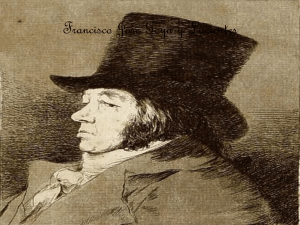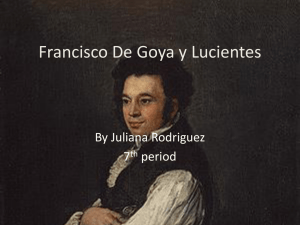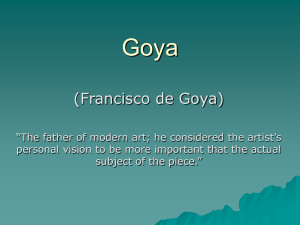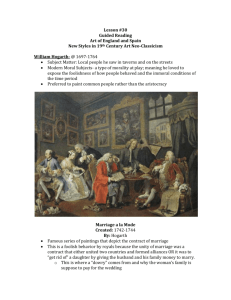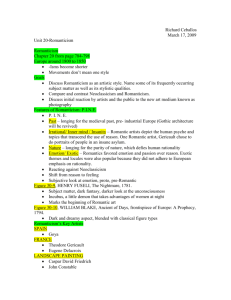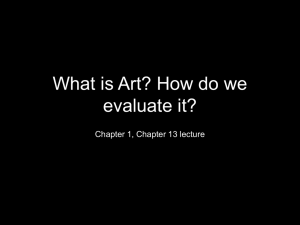Art History Tasks
advertisement
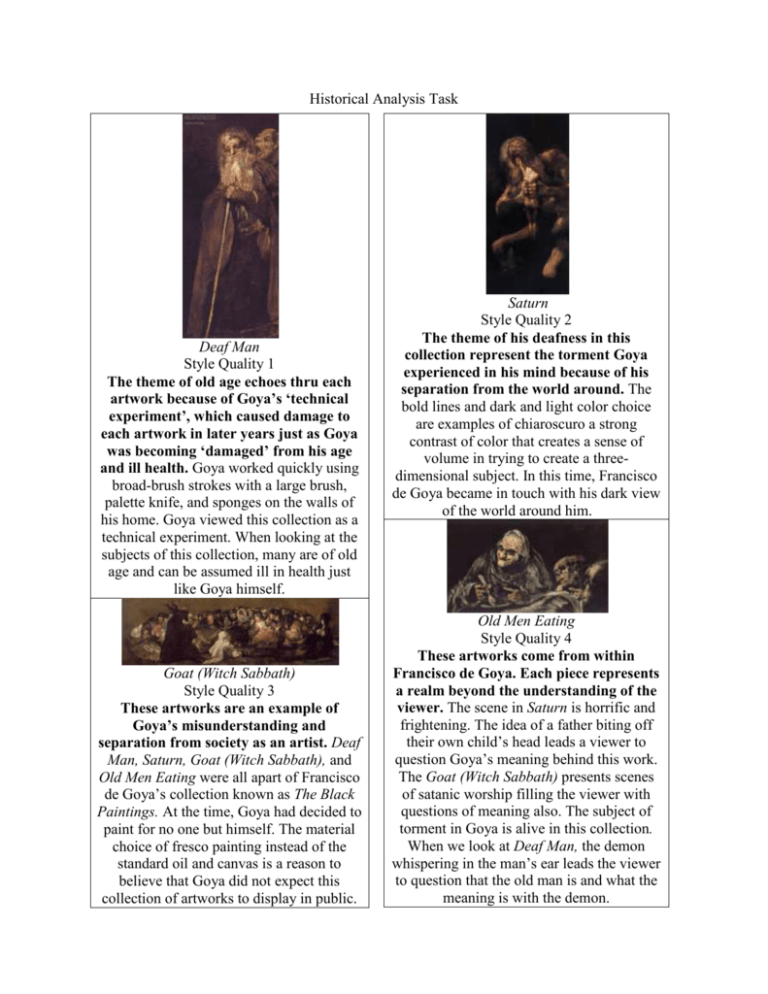
Historical Analysis Task Deaf Man Style Quality 1 The theme of old age echoes thru each artwork because of Goya’s ‘technical experiment’, which caused damage to each artwork in later years just as Goya was becoming ‘damaged’ from his age and ill health. Goya worked quickly using broad-brush strokes with a large brush, palette knife, and sponges on the walls of his home. Goya viewed this collection as a technical experiment. When looking at the subjects of this collection, many are of old age and can be assumed ill in health just like Goya himself. Goat (Witch Sabbath) Style Quality 3 These artworks are an example of Goya’s misunderstanding and separation from society as an artist. Deaf Man, Saturn, Goat (Witch Sabbath), and Old Men Eating were all apart of Francisco de Goya’s collection known as The Black Paintings. At the time, Goya had decided to paint for no one but himself. The material choice of fresco painting instead of the standard oil and canvas is a reason to believe that Goya did not expect this collection of artworks to display in public. Saturn Style Quality 2 The theme of his deafness in this collection represent the torment Goya experienced in his mind because of his separation from the world around. The bold lines and dark and light color choice are examples of chiaroscuro a strong contrast of color that creates a sense of volume in trying to create a threedimensional subject. In this time, Francisco de Goya became in touch with his dark view of the world around him. Old Men Eating Style Quality 4 These artworks come from within Francisco de Goya. Each piece represents a realm beyond the understanding of the viewer. The scene in Saturn is horrific and frightening. The idea of a father biting off their own child’s head leads a viewer to question Goya’s meaning behind this work. The Goat (Witch Sabbath) presents scenes of satanic worship filling the viewer with questions of meaning also. The subject of torment in Goya is alive in this collection. When we look at Deaf Man, the demon whispering in the man’s ear leads the viewer to question that the old man is and what the meaning is with the demon. Art History Tasks AED 201 Michelle Harris Historical Interpretation Task In 1782, Francisco de Goya lost all of his hearing due to an illness believed to be from lead poisoning from his paint. He later moved to a two-story house outside of Madrid, Spain. He moved because Spain was not returning to a liberal government. Goya purposely isolated himself from others. He began to produce The Black Paintings on the walls of his home. Each artwork shows intense haunting themes that reflect Goya’s insanity and his dark outlook on the world outside of his home. According to FamousPainter.com, Goya was “thumbing his nose at the inquisition, with images that conveyed the very essence of heresy” (“Francisco de Goya”). The theme of his illness by the use of browns and blacks unifies the series. Each artwork shows dreary night scenes and distorted faces of tortured subjects. The subjects are like this because Goya had to deal with personal suffering due to being deaf and his exile from society. Saturn is a prime example of Goya’s somber outlook. Saturn was a mythical god who Goya painted eating the head of his child. Saturn has bulging eyes, untamed hair, and fists dripping with his child’s blood. Goya portrayed cannibalistic ways of the Roman god Saturn in an ugly and disgusting way to the public. If one did not know the myth of the god Saturn they would believe that the scene was based on Francisco de Goya’s own understanding, but in thinking about the myth it “clears away assumptions that Goya was a horribly distasteful painter” (Court 3). Goya’s focal point was on the truthful and terrible idea of the myth. Goya's known for this style quality. It is obvious that Goya stressed this style quality due to his hearing loss. When looking at Goya’s Goat (Witch Sabbath) you will also see his somber style quality. In this painting you find a gathering of ‘witches’ “around a demon, or some ecclesiastical authority, which has taken the form of a goat” according to Bozal (qtd. Court 4). Just like the other paintings, this piece's background implies that it is dusk. The darkness makes the subjects unclear, creating a sense of isolation. This isolation refers back to Goya’s isolation from his deafness. The faces of the subjects also have gaping mouths and a sense of terror just like seen in Saturn. Until 1878 when these artworks and others apart of The Blacking Paintings established their fame, Goya had unanimously “been perceived as a completely spontaneous painter” (Court 7). Later with time, “Francisco Goya was known as the Father of Modern Art, his idea that the artist's personal vision had more importance than his subject opened new ways of thinking which helped art break free from commissioned portraits and religious imagery” (“Francisco de Goya”). Deaf Man, Saturn, Goat (Witch Sabbath) and Old Men Eating served as a way for Goya to lessen his anger with his deafness, resulting in his isolation and distinctive style. Works Cited Court, Kimberly. "Goya’s Black Paintings Harsh, but Honest." Washington State University Pullman, Washington. 27 Oct. 2007. Web. 17 Nov. 2010. <http://www.wsu.edu/~kimander/goyasblackpaintings.htm>. "Francisco De Goya." Famous Painter. 7 Nov. 2002. Web. 17 Nov. 2010. <http://www.famouspainter.com/goya.htm>. "Francisco Goya." Learn Spanish in Spain & Latin America - Spanish Schools | Enforex.com. Madrid Chamber of Commerce, 2006. Web. 17 Nov. 2010. <http://www.enforex.com/culture/art-francisco-goya.html>. Voznesensky, Andrei. "Goya - Articles & Biography." Eeweems.com - Site Hosting for Art and Related Subjects - Goya - Capra - Sargent - Michelangelo - Etc. 1997. Web. 17 Nov. 2010. <http://eeweems.com/goya/bio_index.html>.
